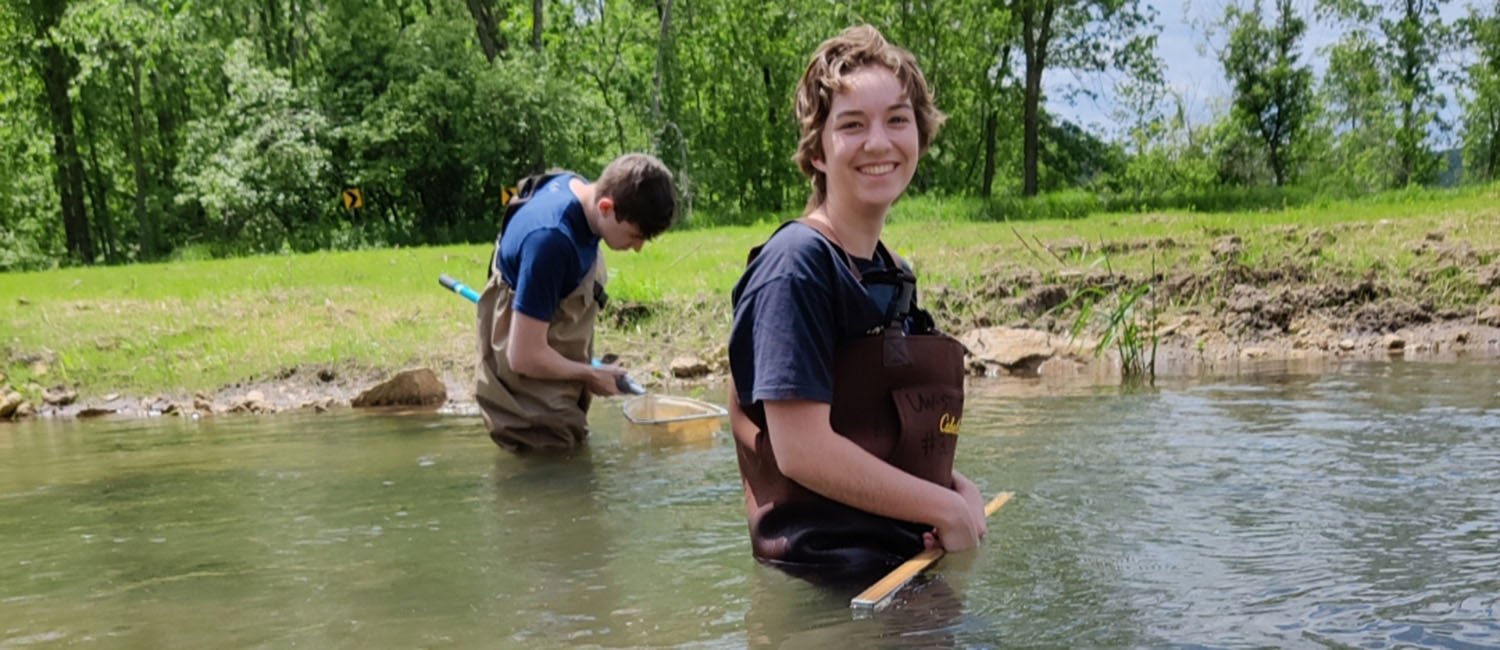With a grant from the Freshwater Collaborative of Wisconsin, three undergraduates from UW-Stout were trained to collect and analyze water samples as part of renewed efforts to monitor restoration efforts in the Red Cedar Basin Watershed, which has high levels of phosphorus pollution. The project brings together UW-Stout faculty from biology and applied social science as well as external partners like the City of Menomonie, Dunn County Land and Water Conservation, and the Red Cedar River Watershed Division of UW-Extension. Read more about the project.
Here’s what students said about their experience.
- Kal Breeden, environmental science sophomore
- Dylan Kostuch, May 2023 applied science graduate
- Britney Serafina, May 2023 environmental science graduate
Why did you choose to participate in this research project?
Serafina: I chose to participate in this research project to broaden my experience and to take on a new opportunity. I thought it would be interesting to have research experience in water quality locally – especially with the reputation that the local lakes have.
What was your role in the project?
Breeden: My role was to conduct field data collection, analysis, and experimentation with my fellow student researchers. Our goal was to gather a large amount of data about the water quality of streams and lakes within the watershed, where data may have previously been sparse in many locations. Most days we were outdoors either in streams or lakes, but some days we worked in the labs at UW-Stout doing experiment setup, data entry, and macroinvertebrate identification. At each stream or lake site we visited we would collect data about the water quality including dissolved oxygen, temperature, turbidity, nutrient content, habitat assessment scores, macroinvertebrate samples, and more. UW-Stout professors instructed us about what data we should collect, sites to visit, methodology, and water-quality experiments to conduct.
What skills did you learn?
Kostuch: I learned a variety of stream and lake sampling methods and how to use the respective equipment involved. I also learned how to perform filtration tests with the lake samples collected to test for levels of chlorophyll. I learned much more about freshwater ecosystems than I had before this past summer. All three of us worked together to collect data and samples throughout the summer, and I was responsible for analyzing and putting together the poster about our data related to Lakes Menomin and Tainter.
Serafina: I learned many skills working on this project. I used many tools and pieces of equipment that I have never used before such as an inflatable boat, a Van Dorn, a dissolved oxygen meter, a PAR light meter, and a flow meter. Other than equipment, it was an awesome opportunity to learn how to use and operate an inflatable boat. I also was able to learn much more about our local water quality and improve my GIS skills.
What has been your favorite part about conducting this research?
Kostuch: My favorite part of this research has been traveling to different sites to collect data and working with my colleagues and professors. It was interesting to see firsthand how the algal blooms developed over the course of the summer.
Breeden: I really enjoyed wading in the streams, many of them were in restoration areas and surrounded by nature. I also enjoyed gaining experience with both fieldwork and lab work and found that I liked having a balance between the two.
Serafina: I have a lot of fun memories from over the summer with Kal and Dylan from sampling. Being able to make a lot of connections whether it be friends, professors, or Research in the Rotunda was my favorite part of this research.
What was the most challenging part?
Breeden: For me, the most challenging part of this project was feeling unsure of how to begin with certain aspects of the research or data analysis. Having only one year of college experience at the time I joined this project, I didn’t have a lot of knowledge or experience with research projects and what it’s like to come up with certain questions that you want to try to answer, or trends you want to explore, and then forming a plan and methodology to go about it. Thankfully we had the guidance of the UW-Stout professors who helped to lead us in the right direction. I learned a lot about what is possible in a project like this and how to form a plan that will lead to useful and meaningful research.
What kind of career do you hope to go into after graduation?
Kostuch: As of now I plan to pursue a career working in a cell biology or molecular biology lab. I have a deep interest in virology and viruses and may even attend graduate school in the future. After this summer experience, I also have a greater interest in limnology and water quality. Should I pursue limnology, the hands-on field experience and lab time will be a great boon.
Breeden: I hope to begin a career in environmental conservation, and this experience has given me many valuable skills that will help me to reach my goals. I feel very confident with the amount of work experience that I’ve gained through this project, particularly from conducting both fieldwork and lab work, and am excited to enter the workforce and continue working on meaningful research projects like this one.
Serafina: I currently have a job lined up as a Land Resource Technician for Chippewa County. This experience has already helped me attain my career goals by giving me the confidence and experience for finding new job opportunities. I am glad that I was able to have this experience.

